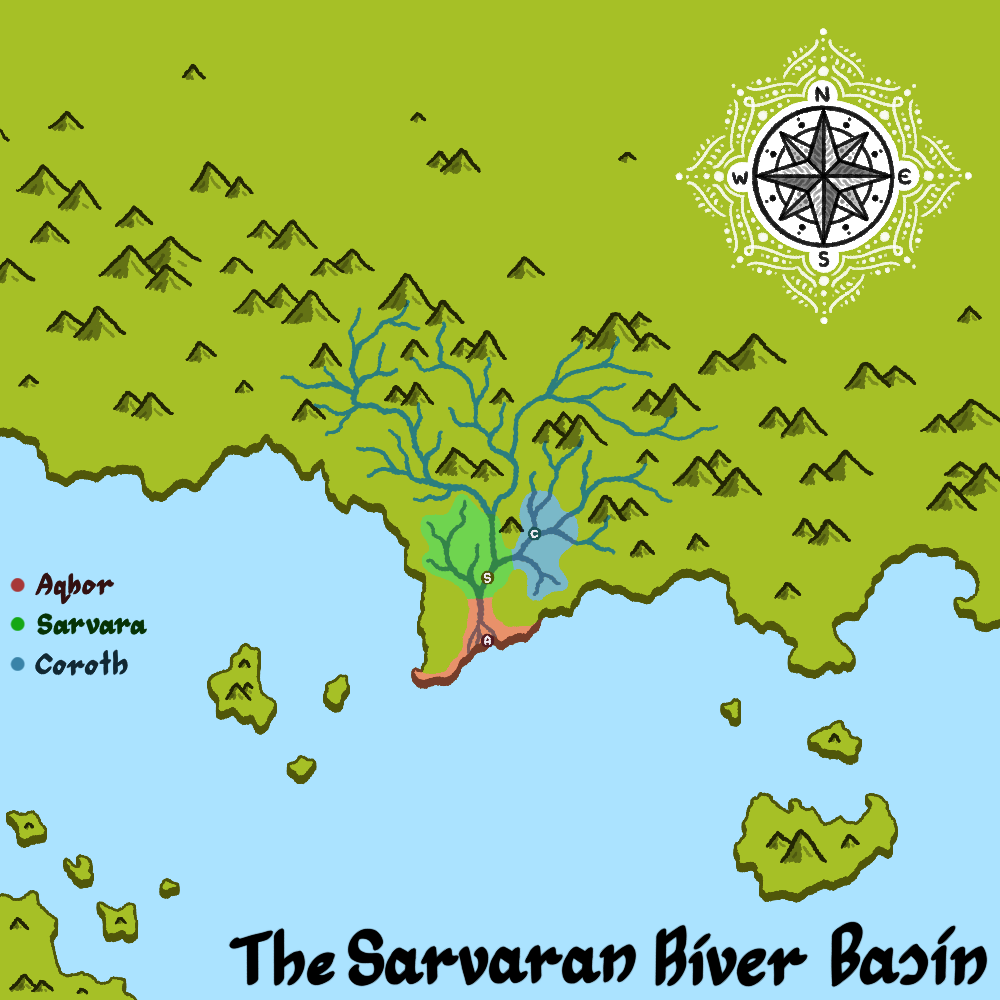Sarvara
# Overview
Sarvara (Sarvaran: ‘Sarvárą’ IPA: /sar.vá.rã/) was a Morellic city state and a civilisation whose society, territory, and culture extended beyond its original city walls. The Sarvaran city and civilisation were located within the Sarvaran river basin, of southern
Tseireph and the
2nd Realm.
Sarvara was founded during the Minikin Neolithic era, reaching its height during the Bronze Age, and was one of the first great cities, alongside Coroth and Aqhor. It held a great amount of influence over the river basin, and served as the foundation for its successor state, the Empire of the Petrified Child.
# Etymology
The name for the city, ‘Sarvárą,’ is made up of two roots, ‘Sarav,’ the name of a river, and ‘Rą,’ meaning ‘City [of].’ The name of the river Sarav was loaned into Old Sarvaran from the native substrate language Old Diiran.
# Location
Sarvara was built on the Sarav river in the Sarvaran river basin, which was in southern Tseireph, a continent of Kherell in the 2nd Realm. It had a mediterranean climate, with seasonal floods from the river. Aqhor was to the south, and Coroth to the northeast.
 The Sarvaran River Basin, with the locations of Sarvara, Aqhor, and Coroth.
The Sarvaran River Basin, with the locations of Sarvara, Aqhor, and Coroth.
# The River Sarav
The river Sarav flows from the northern mountains to the Aqhoran delta (the mouth of the river basin.) It is placed within a mediterranean biome, surrounded by steppes and humid continental biomes, and experiences seasonal floods that greatly enriched the effectiveness of agriculture in the area.
Sarvara is one such city built upon it, as is Aqhor built at it’s delta, and Coroth built on it’s tributary, the river Coroth. During the Sarvaran golden age, Sarvara also controlled another, adjacent stretch of the river basin to the west.
# History
Sarvara was founded by the Mora clan of the nomadic Early Morellic Tribes, who migrated into the Sarvaran river basin from the northeastern steppes. They mostly integrated into the native, sedentary cultures, most notably the Diiran minikin, from whom they gained the name for their holy river - the river Sarav[^1].
Further Reading: Sarvaran History
# Sarvaran Logography
The Sarvaran Golden Age was precipitated by the invention of the Sarvaran Logography. The logography was written from top-to-bottom, carved either into wood or stone with bladed styli or chisels.
The logography resembled that of etruscan or nordic runes of the 0th Realm, and was initially used on wooden tablets for record keeping in trade, production, etc. Eventually, the Sarvaran Golden age saw it begin to be carved into other, similar materials, such as treetrunks, and only be used by nobles and priests.
# Caste System
The sarvaran caste system was divided into 5 hereditary castes, derived from the early Morellic cultural structure, which then became reinforced by taboos and the organisation that came with the advent of the Bronze Age.
# High-Matriarchs
The highest role in Sarvaran society was that of high-matriarchs, queen-like figures who ruled states. However, despite transcending the caste heirarchy, high matriarchs were not a caste in and of themselves, and were counted among the nobles.
# Priests
The highest caste was the priests, who could be of any gender. This caste was derived from the spiritual leaders of the early Morellic tribes, and the duties of the priests were of celibacy, worship, and sacrifice. They led sermons in the temples, and were permitted to write oral tradition.
# Nobles
The second highest caste was the nobles; this caste was earned through honor and age; almost all matriarchs and their husbands were nobles. The nobles often owned land and employed vassals, mostly other nobles and commoners, to live and work there. They commonly conducted accounting work and were permitted to write for this purpose.
# Warriors
The third highest were the warriors. They descended from the early spiritual leaders as well as the priests, but rather focussed more on protection and sorcery rather than pastoral care and worship. They were often seen as dispensible and replaceable, and systemically mistreated, leading to their place in the heirarchy.
# Commoners
The second lowest caste was the commoners. They were the laypeople and workers, vassals of the nobles, and made up the majority of the population in Sarvaran society. They were farmers, builders, smiths, and artists. Commoners were not permitted to write, but were capable of reading to a small extent, for religious purposes.
# Wretched
The lowest caste was the wretched. These were the least in Sarvaran society, those with diseases such as leprosy, those who were dishonoured, and those who had commited social crimes such as treason. The wretched often lived outside of city walls, within primitive and basal communities.
# Calendar
The date of the city’s founding serves as year 0 of the Sarvaran calendar, which was one of the many innovations made by the Sarvaran Minikin. Other notable innovations included pottery, poetry, art, early mass-production, war, and cartography.